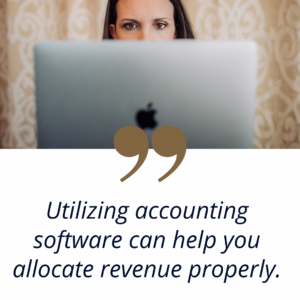How to Allocate Revenue Properly for Business Finances

When it comes to a business’ success, bookkeeping and accurate accounting play a major role. Your company’s financial status is only as healthy as its books are clean. It is vital that you can see precise reports, from revenue to expenses, so that you aren’t leaving money on the table. Money that you could use to pour back into your financial goals for growth. One of the main errors we find in our book reviews is the improper reporting of revenue. It is important to itemize different forms of incoming cash flow. This way, you are getting maximum benefits at tax time, as well as, with government programs like the recent forgivable PPP loans. Here, we break down how to allocate revenue properly.
Let’s look at a hypothetical example.
Let’s say we have a restaurant client who has been allocating all deposits as revenue. These deposits include more than just the cost of goods sold but also tax, tips, gift card purchases and so on. The problem with reporting all funds deposited as revenue – like what was collected for sales tax and money he collected for gratuity to the servers, is that it overstates the amount of revenue the owner actually made, so they end up owing more money to the IRS. It also negates the sales tax that was collected, resulting in more taxes being paid than necessary.
We recommend breaking up your books into clear categories.
Tips
If you’re in a service-based business, like a barber shop or coffee shop, you’re very likely receiving tips from content and consistent customers. Gratuity can really add up! Plus, when separated out could potentially be substantial enough to allocate to a future goal you have for business renovations or even hiring an additional staff member.
You’ll want to acknowledge and assign tips properly in accounting. Since tips can oftentimes be cash transactions, it is best to have a system in place to easily identify such at the end of a busy day.
Taxes
Create separate categories to calculate taxes collected on products and services sold. Consider a title in your accounting records like Revenue-Taxes. Now, when taxes are listed in your profit and loss statement, you can separate income from taxable “out-go”.
In our above example, restaurant sales are retail sales, and are therefore subject to local and state sales tax. Beyond products and services sold, employee payroll is also subject to state unemployment, payroll taxes, Social Security, and Medicare taxes. Obviously, you’ll want to check with your respective state and local laws regarding tax rules and reporting. Typically, business owners must report sales and payroll amounts on a regular basis. This is where having an accountant or bookkeeping software available at any given moment is extremely helpful.
Naturally, the federal government will want their slice of the pie also. This will be based on our restaurant owner’s net profits. Expect to pay quarterly taxes or via payroll volume. The IRS will provide clarity on this when the business owner applies for their EIN.
Apply sales tax to every purchase a customer makes to cover the taxes they will owe the state at the end of the month.
Utilizing accounting software can help you allocate revenue properly.
Simply determine your sales tax rate (typically a percentage like 6%). Then, add up the total of all taxable items sold during a single month of business. Multiply that sales tax rate by the total of all taxable items sold during the month. Record these numbers on the state’s tax forms and write a check for the amount owed. Send it in and take a breath, knowing you’re ahead of the game.
Let’s look at our friend again, the restaurant owner. Let’s say his sales tax rate in his area is 6%. That means he will be charged 6% on all sales made during, for example, this month of March. He will need to be charging his customers that 6% to cover that expense. If he does not, that tax will come out of his pocket and will seriously affect his profitability.
Gift Cards.
Gift certificates (and gift cards) are often sold by a retailer to a buyer for cash. The buyer can then redeem the gift certificate or give it to another person who can redeem the gift certificate for merchandise or services. When it comes to accounting, the sale of a gift certificate should be recorded as an outstanding credit. Revenue is not typically recorded at this point as the services have yet to be rendered to honor the gift card purchase. Instead, consider categorizing the gift certificate as a future obligation to provide merchandise or services for the amount of the certificate sold. Then, once the recipient presents the gift card to the retailer, record it as revenue.
Like people, companies need annual wellness checks too. Two Sense’s small-business consulting offers an objective third party look through financial statements. We can then make suggestions and ask questions to provoke new lines of thought for your bottom and top-line strategies. Clean books make for clarity in your business’ future and we are here to help!









